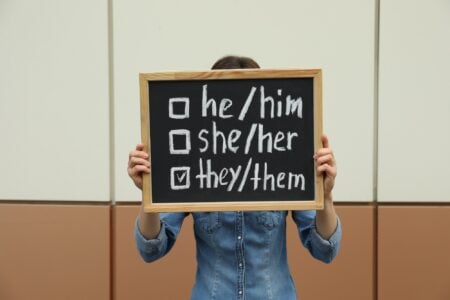I will provide a simple definition of pronouns and walk you through the 10 main types. We will cover personal, possessive, intensive pronouns, and more.
Plus, I have compiled a comprehensive list of pronouns with over 75 examples. You will master these essential parts of speech in no time.
Pronouns Explained
What Is a Pronoun?
Pronouns are the stunt doubles of the grammar world. We use them to replace nouns and proper nouns to make our writing efficient and less repetitive.
These words stand in for nouns when the audience already knows who or what you are discussing. Imagine if we didn’t use them. You might say: “Deborah packed Deborah’s lunch. When Deborah got to work, Deborah ate Deborah’s lunch.”
That sounds exhausting. Since we know the subject is Deborah, we can swap the nouns for pronouns. The sentence becomes: “Deborah packed her lunch. When she got to work, she ate it.”
We use these words in almost every sentence. They function just like nouns, acting as the subject or object of a sentence.
Types of Pronouns
There are several categories of pronouns, each serving a specific role. I will break down the 10 distinct types, commonly used examples, and how to use them correctly.
Here are the main categories:
- Personal (subject or object) pronouns
- Possessive pronouns
- Reflexive pronouns
- Intensive pronouns
- Indefinite pronouns
- Demonstrative pronouns
- Interrogative pronouns
- Relative pronouns
- Reciprocal pronouns
- Archaic pronouns
Personal Pronouns
Personal pronouns refer to specific people, animals, or objects. These are the most common types used in daily conversation and storytelling.
The form changes based on point of view (first, second, or third person), number (singular or plural), and gender. Common examples include I, you, they, us, and it.
Personal pronouns split into two sub-categories: subject and object.
Subject Pronouns
Subject pronouns replace the specific noun performing the action. You will usually find these at the start of a sentence or clause.
For example: “They are going to the movies.” Here, they is the subject pronoun because they are the ones performing the action.
Commonly Used Subject Pronouns
Here is a list of standard subject pronouns:
- He
- I
- It
- One
- She
- They
- We
- You
How To Use Subject Pronouns
Use these when the “who” or “what” of the sentence is clear. Ensure the pronoun matches the gender and number of the noun it replaces.
Here are five examples of subject pronouns in action:
- Kevin loves Christmas. He cannot wait for Santa to arrive.
- Amanda and Jake invited me out. We are going to see a movie.
- The fish are hungry. They need some food.
- Did you know Greg got an A+ on the exam?
- Have you seen my keys? I cannot find them.
Object Pronouns
Object pronouns replace the noun receiving the action. In the sentence “They are going to the movies,” movies is the object. If we replace it, we say: “They are going there.”
Commonly Used Object Pronouns
These are the most frequent object pronouns:
- Her
- Him
- It
- Me
- One
- Them
- Us
- Whom
- You
How To Use Object Pronouns
Use these to replace the noun receiving the verb’s action. Like subject pronouns, they must match the gender and number of the original noun.
Here are five examples of object pronouns:
- Timmy always goes with us to the park.
- Has Lisa told them the news?
- I needed Bernie to pick me up.
- “Where is Paul? I thought Molly was with him,” Christine said.
- The hotel is close. You cannot miss it!
Possessive Pronouns
Possessive pronouns show ownership. They replace a noun phrase to identify a relationship between an owner and an item.
For example: “That sweater is Sarah’s, but this red one is mine.” Here, mine replaces “my sweater.”
Note the difference between possessive pronouns (mine, yours, theirs) and possessive adjectives (my, your, their). Adjectives come before the noun (my cat), while pronouns stand alone (the cat is mine).
Commonly Used Possessive Pronouns
These are the standard forms indicating possession:
- Hers
- His
- Its
- Mine
- Ours
- Theirs
- Yours
How To Use Possessive Pronouns
Use these to avoid repeating names or objects. You would rarely say, “That is Sarah’s, but this is my sweater.” It flows better to say, “It is mine.”
Here are five examples:
- I found money outside my parents’ house. I think it is theirs.
- I bought this jacket because its lining is soft.
- Eleanor brought cake. “It is yours if you like lemon,” she said.
- Wilfred lives on Smith Street, but I do not know which house is his.
- I cannot believe my sister stole my makeup. It is mine!
Reflexive Pronouns
Reflexive pronouns end in -self or -selves. We use them when the subject performs an action on itself. The subject and the object refer to the same person or thing.
For example: “He hurt himself playing soccer.” The person doing the hurting and the person getting hurt are the same.
Commonly Used Reflexive Pronouns
Here are the primary reflexive forms:
- Herself
- Himself
- Itself
- Myself
- Oneself
- Ourselves
- Themself
- Themselves
- Yourself
- Yourselves
How To Use Reflexive Pronouns
Use these when the action reflects back on the doer.
Consider these five examples:
- Be careful with scissors, or you might injure yourself.
- Jeremiah took himself to the movies.
- “Fine. I will do it myself,” I said.
- “Enjoy yourselves at the party,” said Tori.
- We did the project ourselves.
Intensive Pronouns
Intensive pronouns look identical to reflexive pronouns (ending in -self or -selves), but they function differently. They add emphasis to a noun or pronoun already in the sentence.
For instance: “I myself have never been camping.”
The sentence still makes grammatical sense if you remove the intensive pronoun (“I have never been camping”), but the meaning loses its punch.
How To Use Intensive Pronouns
Place the intensive pronoun directly after the noun or pronoun you want to emphasize. Occasionally, it appears at the end of the sentence.
Here are five examples:
- I myself have savings.
- The manager themself announced the closing.
- You can clean the room yourselves.
- The policeman himself came to the door.
- You yourself cooked the dinner!
Indefinite Pronouns
Indefinite pronouns refer to people or things generally, without identifying exactly who or what they are. They are vague but essential for broad statements.
You might say, “Everybody was dancing,” or “Something smells good.”
Commonly Used Indefinite Pronouns
Here is a list of frequent indefinite pronouns:
- All
- Another
- Any
- Anybody
- Anyone
- Anything
- Both
- Each
- Either
- Everybody
- Everyone
- Everything
- Few
- Many
- Most
- Nobody
- None
- No one
- Nothing
- One
- Other(s)
- Several
- Some
- Somebody
- Someone
- Something
How To Use Indefinite Pronouns
Many indefinite pronouns are singular and require singular verbs, even if they seem to refer to a group. For example: “Everybody is here.” (Not “Everybody are here”).
However, pronouns like both, many, and several take plural verbs: “Both are going tonight.”
Here are five examples:
- Amber did not know anybody at the party.
- Of all the books I read, most were thrillers.
- Nobody answered the door.
- Are any of the gifts for me?
- Everybody forgot about me.
Demonstrative Pronouns
Demonstrative pronouns point to specific things. They replace specific nouns based on distance and number.
If you hold a book, you say, “This is mine.” If the book is across the room, you say, “That is mine.”
Commonly Used Demonstrative Pronouns
The four core demonstrative pronouns are:
- This (singular, near)
- That (singular, far)
- These (plural, near)
- Those (plural, far)
How To Use Demonstrative Pronouns
Use these only when the listener knows what you are pointing to. Context is key.
Here are five examples:
- Joseph sipped his coffee. “This is delicious.”
- “That will break,” the mother warned.
- I bought these from the pharmacy.
- I can get rid of those old shoes now.
- Neither is suitable for the job.
Interrogative Pronouns
We use interrogative pronouns to ask questions. They represent the “unknown” answer we are looking for.
Common examples include: “Who is calling?” or “What is that?”
Commonly Used Interrogative Pronouns
These are the standard question-starters:
- What
- Whatever
- Which
- Whichever
- Who
- Whoever
- Whom
- Whomever
- Whose
How To Use Interrogative Pronouns
Use these when you are missing information. For example, if you find dirty dishes but don’t know the culprit, you ask: “Who left these here?”
Here are five examples:
- I am excited to see whoever is headlining.
- Whose bike is this?
- Bobby will hire whomever I recommend.
- Whatever is the meaning of this?
- Which road is fastest?
Relative Pronouns
Relative pronouns connect a clause to a noun to provide more information. They introduce a relative clause.
For example: “The girl who moved in next door is nice.” The word who links “the girl” to the fact that she moved in.
Commonly Used Relative Pronouns
These words link clauses together:
- As
- That
- What
- Whatever
- When
- Which
- Whichever
- Who
- Whoever
- Whom
- Whomever
- Whose
How To Use Relative Pronouns
Place the relative pronoun immediately after the noun it describes (the antecedent).
Here are five examples:
- Caleb, whom I have not met, arrives soon.
- I will take whatever you offer.
- My course, which is difficult, is taught by an expert.
- The shoes that I wore are muddy.
- The baby whose blanket fell is crying.
Reciprocal Pronouns
Reciprocal pronouns indicate a mutual relationship or action. They show that two or more subjects are acting upon one another.
There are only two reciprocal pronouns in English:
- Each other: Used for two people or things.
- One another: Used for more than two people or things.
How To Use Reciprocal Pronouns
Use these when feelings or actions are shared.
- My parents love each other very much.
- The team members supported one another during the crisis.
Archaic Pronouns
You will rarely use archaic pronouns in modern emails or texts, but you will see them in Shakespeare, the Bible, or fantasy novels. They are simply older versions of “you” and “yours.”
Commonly Used Archaic Pronouns
These historical terms include:
- Thee (you – object)
- Thine (yours)
- Thou (you – subject)
- Thy (your)
- Ye (you – plural)
How To Use Archaic Pronouns
Unless you are writing a period piece or a poem, avoid these in daily writing.
Here are examples of how they function:
- Thou art a villain.
- Ye must have faith.
- Take thy cup and drink.
Alphabetical List of All Pronouns
Here is a comprehensive reference list of pronouns in English.
- All
- Another
- Any
- Anybody
- Anyone
- Anything
- As
- Both
- Each
- Each other
- Either
- Everybody
- Everyone
- Everything
- Few
- He
- Her
- Hers
- Herself
- Him
- Himself
- His
- I
- It
- Itself
- Many
- Me
- Mine
- Most
- Myself
- Neither
- Nobody
- None
- No one
- Nothing
- One
- One another
- Oneself
- Other(s)
- Ours
- Ourselves
- Several
- She
- Some
- Somebody
- Someone
- Something
- Such
- That
- Thee
- Theirs
- Them
- Themself
- Themselves
- These
- They
- Thine
- This
- Those
- Thou
- Thy
- Thyself
- Us
- We
- What
- Whatever
- When
- Which
- Whichever
- Who
- Whom
- Whomever
- Whose
- Ye
- You
- Yours
- Yourself
- Yourselves









